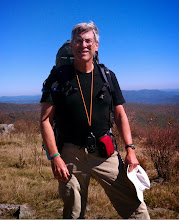You may remember my very first post about a hike at Back Bay National Wildlife Refuge, in September, 2008. (Okay, of course you don't remember it - it was over four years ago, but you can visit it here.)
One of the things I talked about in that post was a simple yet beautiful memorial to Captain Richard McCormick Hodge. I am posting the photograph again of this memorial to a young man who's untimely death came at the age of just 30:
For years now, I have wondered who Richard McCormick Hodge was, and how he died. Was he a captain in the Army or Marine Corps (he was too young to be a Navy Captain)? Was he a police or fire captain? Did he die in the line of duty? Was he a sea captain? He obviously had parents, siblings, and friends who loved him deeply to erect this memorial in such a pacific and lovely spot - near a little fresh water pond and just a dozen or so meters from the shores of Back Bay.
Every time I hike this trail, I stop at this monument and reflect about Captain Hodge - sometimes for just a few seconds, other times for a few minutes. I have taken family and friends there, and they are always moved. I Googled his name, but at the time of his death in 1994, the commercial internet was in its infancy, and I found nothing.
Then yesterday, I got this email from a friend of his, and the mystery was resolved:
"Hello. I just read your blog from 2008 from Back Bay Wildlife Refuge about the memorial to our dear friend Richard Hodge! Saturday would have been his 49th birthday, so for kicks, we googled his name and your blog turned up. We grew up with Richard, aka Chard, in Fredericksburg VA and several of us moved to Virginia Beach in the mid eighties. Richard became a boat captain and spent time in VA Beach, Florida, Outer Banks, and the Virgin Islands. He died in 1994 in a boating accident. He loved the water so much, so we spread his ashes at sea off the coast of Back Bay and placed the memorial along the trails. It was so nice to read your post, as it is a special place for us too. Happy trails to you!"
I really appreciated this kind note, and I know that the next time that I hike this trail - and every time thereafter - I will think a little more than usual about this young man who died so tragically and so prematurely, even though it was doing something he loved. I bet that he lived life to the fullest and had many adventures along the way. But his run of adventures, his sunrises and sunsets, was done way too soon.
May you rest well in eternal peace, Captain Richard Hodge!
Top 12 Moments in My Racing for a Cure Memories
11 years ago












































